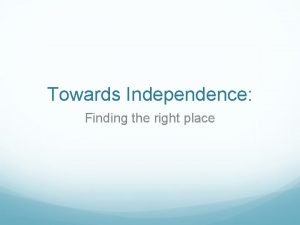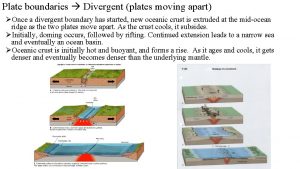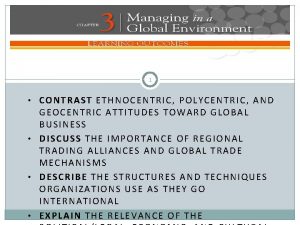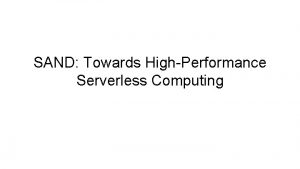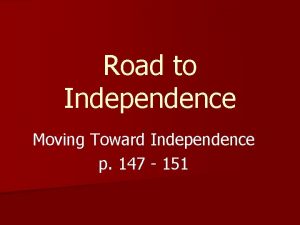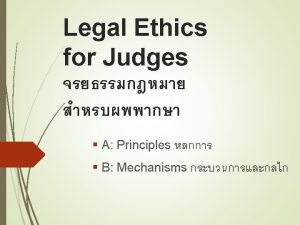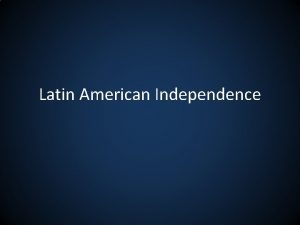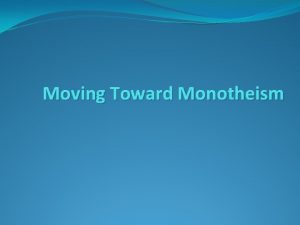Steps Towards Independence Steps Toward Independence n In











- Slides: 11

Steps Towards Independence

Steps Toward Independence n In Sept 1774, 55 delegates met in Philadelphia for First Continental Congress in response to the Coercive Acts: –Suffolk Resolves urged forcible resistance to the Coercive Acts –Formed an inter-colonial “association” to enforce a boycott with Britain until the Coercive Acts were repealed

The Shot Heard Around the World n On April 18, 1775 a skirmish broke out in Lexington, Massachusetts n Fighting by colonial “minutemen” & British soldiers between Lexington, Concord, & Boston became the first exchange of hostilities between the English & Americans

British for Thesoldiers Britishwere are looking coming!! contraband weapons & Sons of Liberty leaders John Hancock & Samuel Adams Paul Revere & William Dawes made their midnight ride to warn the Minutemen of approaching British army

“The Shot Heard ‘Round the World” “Americans displayed a…spirit against us, they never showed against the French” Lexington & Concord—April 18, 1775

Early War Effort n On May 1775, Second Continental Congress met to direct the war: –Appointed G. Washington to lead a new “Continental Army” –Began purchasing war supplies –Did not declare independence (delegates hoped to be seen as an expression of colonial opinion, not as a factional coup d’etat)

The Early War Effort n Dec 1775, Parliament passed the Prohibitory Act to restrict the colonists from trading with anyone –English blockaded colonial ports & seized American ships –Hired German mercenaries (Hessians) Hessians to fight the rebellion –Royal governors urged slaves to rebel against their masters

Conclusions n By December 1775, the British & American colonists were fighting an “informal revolutionary war”…but: –Colonial leaders had not yet declared independence –Most colonists were “loyal & dutiful subjects” of England & asked King George III to protect them against the king's ministers –King George already considered the colonists in “open rebellion”

What’s Next?

n Let’s take a look at our Path Towards the American Revolution chart: –Which factor was most important in leading to the outbreak of war between the American colonies & England: political or economic stress? –From your “point of view, ” (from Friday) after which event on the chronology was the “point of no return”?

Path Towards Revolution Activity Discussion Questions n What could the British have done (in the time right before the “breaking point”) to halt the escalation of colonial resistance? n What could the colonists have done to appease Britain? n Who was more to blame for the American Revolution, inept British officials (Grenville, Townshend) or radical colonists (Sons of Liberty)?
 Towards independence commerce program
Towards independence commerce program Steps toward artificial intelligence
Steps toward artificial intelligence Comparison using like or as
Comparison using like or as Casting off with wind toward dock
Casting off with wind toward dock 10 steps to teaching and learning independence
10 steps to teaching and learning independence Divergent boundary
Divergent boundary His wrath towards you burns like fire figurative language
His wrath towards you burns like fire figurative language What is polycentric attitude
What is polycentric attitude Halliday 1993
Halliday 1993 What is character formation all about
What is character formation all about Act towards
Act towards Sand: towards high-performance serverless computing
Sand: towards high-performance serverless computing
